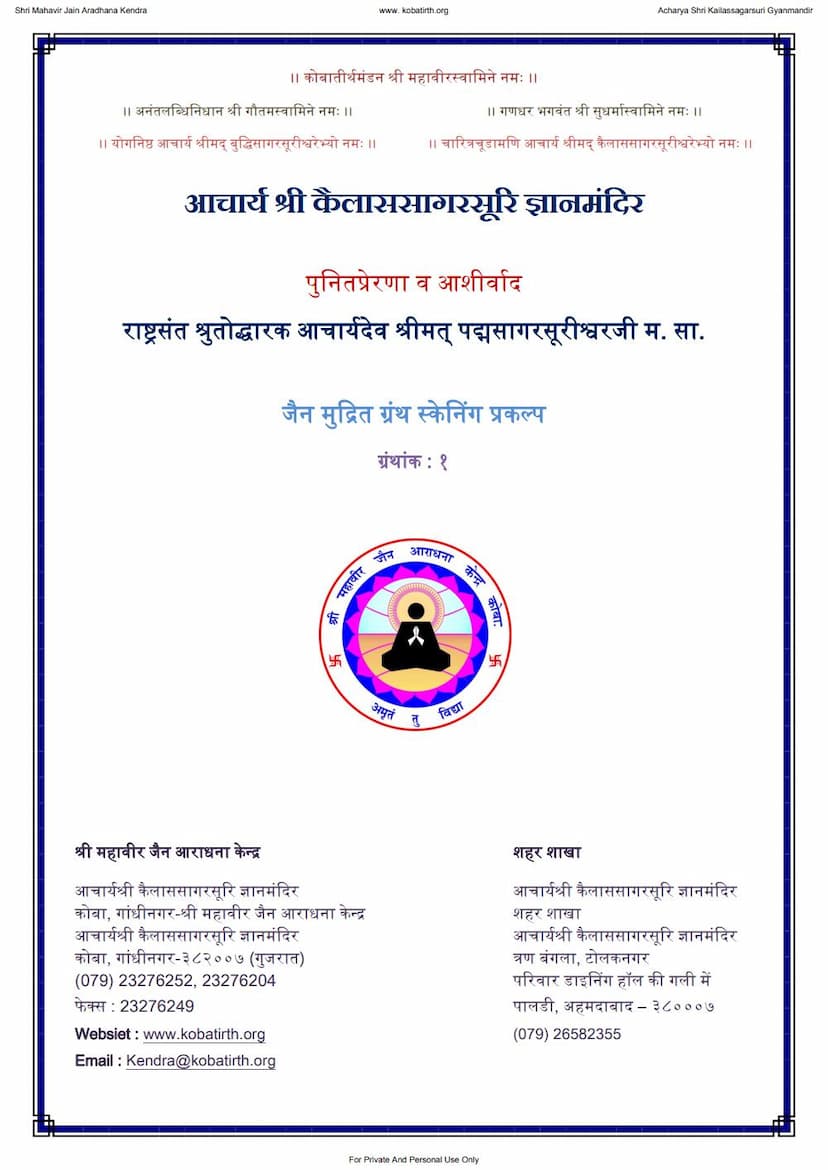Taittiriya Samhita Part 01
Added to library: September 2, 2025

Summary
Here's a comprehensive summary of the provided Jain text, "Taittiriya Samhita Part 01," based on the scanned pages you provided.
Book Title: Taittiriya Samhita Part 01 Author(s): A Mahadev Shastri, K Rangacharya Publisher: Government of Mysore Publication Year: 1894
Overview:
This volume is the first part of the Taittiriya Samhita of the Black Yajur-Veda, presented with the commentary of Bhattabháskara Mis'ra. Edited by A. Mahadeva Sastri and K. Rangacharya, it was published under the authority of the Government of His Highness the Maharaja of Mysore. The volume focuses on the first three Praśnas (sections) of the first Kanda (book) of the Taittiriya Samhita.
Key Features and Content:
-
Textual Presentation: The edition provides the original Samhita and Pada texts of the mantras, along with Bhattabháskara's extensive commentary. The Pada text for the first Praśna of Kanda I is appended separately due to it being an "afterthought" in the editing process. Sub-sections are clearly marked within the Pada text to facilitate referencing the commentary.
-
Commentary's Basis: The editors utilized several manuscripts for preparing the commentary, including Grantha and Telugu manuscripts from the Sarasvatí Bhandára of the Maharaja of Mysore, Vizagapatam, and the Palace Library at Tanjore. Dr. Weber's edition of Káņdánukramaní was also consulted.
-
Structure of the Volume:
- Kanda I, Praśna 1 (Pages 8-58): This section details mantras related to the Darshapūrṇamāsa (New Moon and Full Moon sacrifices). It covers rituals like the removal of calves (vatsapākaraṇa), fetching ghee (grahṇa), offering grains (havirnirvāpa), preparing the altar (vedikaraṇa), and various specialized offerings (kāmyeṣṭikāṇḍa).
- Kanda I, Praśna 2 (Pages 59-136): This part deals with mantras associated with the Soma Soma-krayārtha (purchase of Soma) and the subsequent rituals. It includes mantras for entering the shed (śālā), initiation (dīkṣā), acceptance of the sacrificial ground (devayajana), the actual purchase of Soma, the process of pressing Soma (somābhiṣava), and various other Śrauta sacrifices.
- Kanda I, Praśna 3 (Pages 137-379): This section continues with mantras related to the Adhvara (the main Soma sacrifice) and associated rituals. It covers the construction of the Sadas (assembly hall), the altar (uttaravedi), the Havirdhāna (structure for Soma vessels), and offerings for various deities (iṣṭī). Specific mantras are detailed for sacrifices dedicated to Agniṣomīya, Rudra, and other deities.
-
Bhattabháskara's Commentary Style: The commentary is characterized by its deep dive into grammatical analysis (pada and grammar), etymology (nirukta), ritualistic significance (vinīyoga), and philosophical interpretations. It meticulously explains the meaning of each mantra, the context of its application, and the underlying principles. The commentary often refers to Brahmanas and other Vedic texts to support its explanations.
-
Purpose of the Text: The Taittiriya Samhita, as explained in the commentary, is a collection of mantras intended for sacrificial performance. The commentary emphasizes the importance of understanding the meaning (artha) of the mantras for effective ritual practice, stating that mantras with unknown meanings are not capable of fulfilling their purpose. It highlights the connection between knowledge of the Veda and achieving desired results in rituals.
-
Author's Dedication: The editors express their dedication to the "Jain Education International" and note that the text is for "Private And Personal Use Only." The initial pages also include devotional salutations to Jain figures like Shri Mahavir, Shri Gautam, and various Acharyas, indicating a Jain context for the preservation and dissemination of this Vedic text.
Significance:
This volume is a valuable resource for scholars and practitioners of Vedic ritual and Sanskrit studies. It provides a critical edition of a significant portion of the Yajur-Veda with a historically important commentary, offering insights into the complex ritualistic traditions and the intellectual world of ancient India. The meticulous editing and comprehensive commentary make it an authoritative source for understanding these Vedic texts.